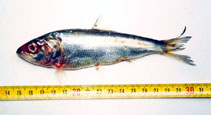| Family: |
Alosidae (Shads and Sardines) |
| Max. size: |
35.1 cm FL (male/unsexed); max.weight: 600.0 g; max. reported age: 10 years |
| Environment: |
pelagic; freshwater |
| Distribution: |
Europe: Lakes Koronia (extirpated) and Volvi, Greece (ref. 59043). |
| Diagnosis: |
Dorsal spines (total): 3-4; Dorsal soft rays (total): 12-14; Anal spines: 3-4; Anal soft rays: 16-21. This species is distinguished from its congeners entering the freshwater in Mediterranean basin by the following characters: gill rakers 106-128; teeth on palatine and vomer well-developed, especially in juveniles (Ref. 59043). |
| Biology: |
Landlocked, lacustrine, pelagic, in upper water layers during summer and descending to deeper layers in winter. It spawns at 1-2 years, near shores above gravel or coarse sand, with most individuals spawning more than one season. Spawning starts when temperature reach about 19-20°C, in July to August (Ref. 59043). Adults form schools in the epilimnion during summer and tend to congregate in shallow waters near shores. They feed on plankton (cladocerans and copepods) and small fishes (Ref. 10545, 59043). It is threatened by water abstraction and pollution (Ref. 26100). |
| IUCN Red List Status: |
Critically Endangered (CR); Date assessed: 04 November 2023 (Critically Endangered) Ref. (130435)
|
| Threat to humans: |
harmless |
Source and more info: www.fishbase.org. For personal, classroom, and other internal use only. Not for publication.
